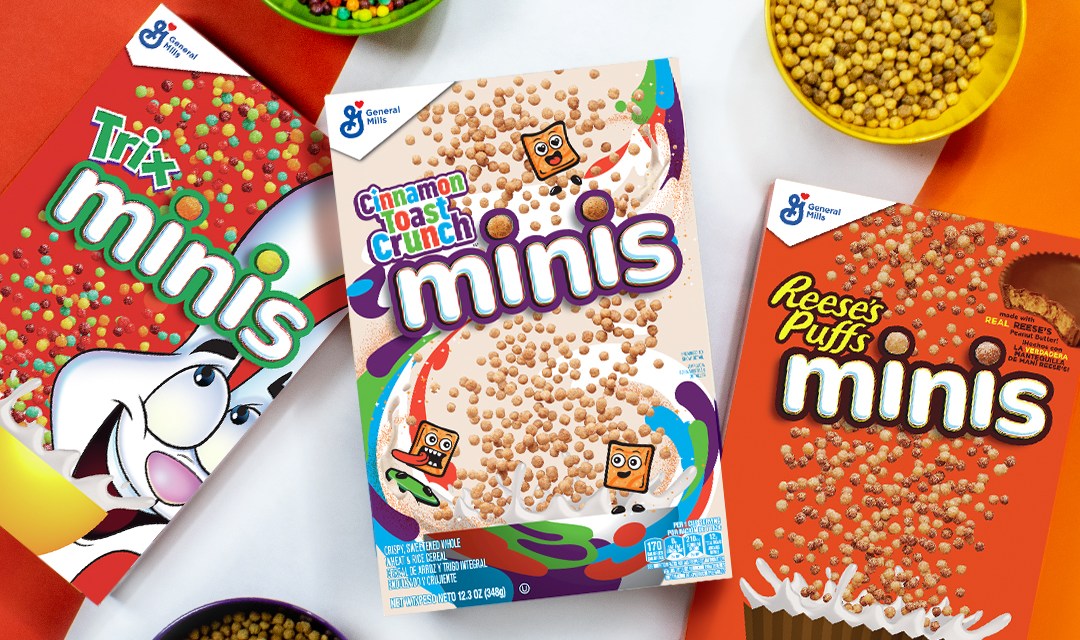Why CPG brands are betting on mini versions of household snacks

As the snacking market in the U.S. continues to grow big, CPG brands are looking at a small solution to meet the demand: mini-sized products.
CPG food brands have increasingly been adding smaller-sized versions of their signature snacks. General Mills announced that it was releasing miniature versions of its popular Trix, Reese’s Puffs and Cinnamon Toast Crunch cereals — each one had been adjusted to be shaped small and round. PepsiCo’s Frito-Lay, on the other hand, unveiled bite-sized versions of Doritos, Cheetos and SunChips snacks, which have been packed in canisters to make it easier to eat with a group and on the go.
Introducing miniature options of popular brands is by no means new. Brands have been introducing various sizing options, both packaging- and product-wise, to fit the shifting eating habits and drive top-of-mind awareness among consumers. Now, large CPG brands are positioning snacking as a cheap form of luxury as they see demand for the category grow over the past few months. Offering bite-sized varieties make their products more convenient for snacking and allows them to generate buzz around an old product.
In addition to its marketing benefits and adaptability to different snacking occasions, offering smaller sizes for existing products also allow retailers to cater to health-conscious shoppers who still want to enjoy their favorite treat in easy-to-control portions, said Jaime Reeves, evp Product Development & Commercialization at Mattson, a food and beverage insights, strategy, innovation and product development firm.
“The smaller size, kind of stackable [products] are really designed for the lunchbox segment,” Reeves said. “This is a trend that… allows people to indulge in their favorite snacks on the go, but thinking about their waistline.”
Less is more for snack-makers
Indeed, brands have been taking note of consumers’ shifting snacking habits during a period when the cost of goods and services have significantly risen. PepsiCo CEO Ramon Laguarta said the company is seeing “huge growth [in] small-format” snacks in an earnings call back in July. In Pepsi’s most recent earnings call Laguarta said the company is “looking at multiple ways to increase our revenue per kilo,” while assuring investors and analysts that it can manage the complexities of adding a variety of product sizes to its portfolio.
“As consumers are facing price increases at shelves and they are considering trading down to store brands or private label products, providing alternatives for consumers to stay within the brand family is definitely a strategic opportunity,” said Greg Carlucci, senior director analyst for consumer goods at Gartner.
Snack sales have been rising significantly due in part to inflation and people leaning towards snacking than eating traditional meals. General Mills’ net sales in its most recent quarter rose 4% year-over-year to $4.7 billion, while, PepsiCo’s net revenue grew 8.8% year-over-year in the third quarter to $21.97 billion. According to a snacking survey from Mondelez, 62% of respondents said they’ve replaced at least one meal per day with a snack.
Ad position: web_incontent_pos1
Carly Sutherland, a brand and communications strategy consultant, said that having smaller sizes opens up a new opportunity for some brands to break into a category that they weren’t exactly in before. This is the case for some of General Mills’ mini cereal options. Instead of only being a breakfast option, Sutherland said these cereals become more optimal for snacking purposes.
“Now they can actually potentially enter the snack aisle,” Sutherland said. “It’s just another way of expanding on their portfolio using an existing product.”
When the existing product has been around for a while, Barb Stuckey, chief innovation and marketing officer at Mattson, said that these miniature options also present brands with the opportunity to remind people of their products, both through the media and in physical stores.
“If the retailer accepts the product, that gives you additional facings on the shelf so that makes you basically more prevalent in the consumers’ mind if they’re shopping the category that you’re in,” Stuckey said. “Oftentimes, it helps to have more products within the same category so you get what we call a brand block.”
Hostess Brands, for example, just launched Bouncers, which are essentially bite-sized versions of Twinkies, Ding Dongs and Donettes. Although it is home to classic treats, the brand hopes that by launching these options, it would partly keep its products in the mind of consumers. “It’s not because they don’t know what Hostess is [or] they don’t have positive associations with Hostess, it’s just that they’ve forgotten,” Tina Lambert, vice president, marketing center of excellence for Hostess Brands, told Food Dive.
Ad position: web_incontent_pos2
However, experts warn that by offering these miniature versions they run the risk of cannibalizing their core product. That means if people begin buying these mini options, it could prevent them from buying the regular-sized option.
Stuckey said that in order for these smaller sizes to be a long-term success, brands need to create a new occasion or reason for people to consume the mini version as opposed to the regular one. PepsiCo’s Frito-Lay mini products, for instance, make it easier to consume while traveling because of the resealable packaging.
“A lot of these categories are old categories. They have been around for decades,” Stuckey said. “It’s like infusing new life into a really old kind of predictable brand and category.”

